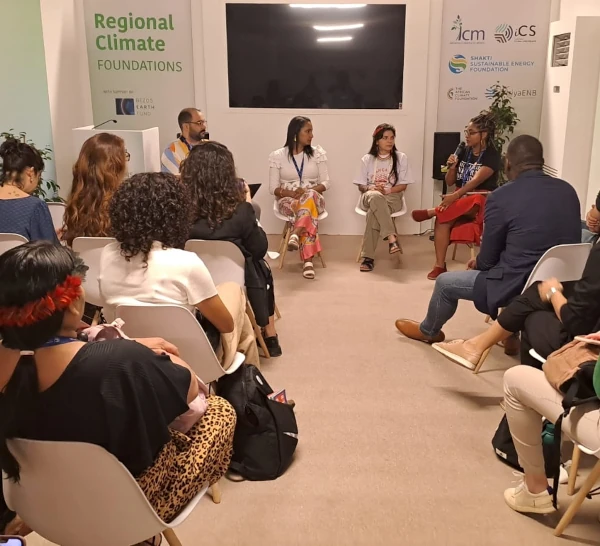A place within the UN Climate Change Conference where participants can discuss solutions to the climate emergency developed on four different continents and face-to-face with people involved in each project. This is the objective of the Regional Climate Foundations (RCF) Pavilion, which will be installed in the Blue Zone of COP 29 in Baku, Azerbaijan. From 12 to 22 November, the pavilion will promote debates and meetings on key issues related to the climate crisis and ways to achieve the goals of the Paris Agreement.
Composed by eight philanthropic organisations from the Americas, Africa, Asia, and Europe, the Regional Climate Foundations Pavilion aims to showcase projects and hear local voices that can lead participants to answer the question: what needs to be done to stop climate change?
The members of the group are The African Climate Foundation, European Climate Foundation, Tara Climate Foundation, that operates in Asia, ViriyaENB Foundation, from Indonesia, Shakti Sustainable Energy Foundation from India, Energy Foundation China, Iniciativa Climática de México and Instituto Clima e Sociedade from Brazil. As philanthropic foundations, they work by providing grants to other organisations and building strong civil society networks in the areas where they operate. Some of these grantees will be speakers at the pavilion.
“The regional climate foundations play a pivotal role in shaping and executing a wide array of climate action strategies”, explains Sreyamsa Bairiganjan, Chief of Programmes at Shakti Sustainable Energy Foundation. “Through their efforts, they are helping countries align their policies with global climate goals by mobilising resources and building the capacity of civil society organisations”, continues.
The pavilion’s programme will include debates, workshops and cultural events that will address the key issues that negotiators will be discussing at COP 29, as the new round of NDCs for the 1.5 °C goal, climate finance, adaptation and nature-based solutions, among others. “This pavilion wants to discuss what the priorities should be in the two weeks of negotiations and what efforts have been made to accelerate climate ambition”, expects Mariana Gutiérrez Grados, climate policy manager at Iniciativa Climática de México.
The pavilion will include a debate arena with a stage and seating for 40 people, as well as meeting rooms accessible to wheelchair users and people with reduced mobility.
Global dialogue
The organisations that compose the Regional Climate Foundations are used to attending climate conferences as observers. But this will be the second time that the group has been organised under the same brand and also will share the same physical space at the UN Climate Change Conference.
“I have seen enormous progress made by the regional climate foundations, and there is a growing leadership core within the RCF. The group is starting to make its presence felt, and the pavilion is a sort of external expression of that solidification”, says Saliem Fakir, the Executive Director of The African Climate Foundation.
In 2024, the group will have new participants, as the European Climate Foundation. “Last year, we were only countries from the global South. Now, we want to pass the message that without the collaboration between the North and the South, it would be very difficult to implement climate policies that meet the needs of countries”, explains Mariana Gutiérrez Grados.
The diversity of geographies represented in the RCF, and the priority issues for each of them, adds more value to the debates, according to Cintya Feitosa, the international strategy specialist at the Instituto Clima e Sociedade in Brazil. “We create networks around a common goal, but that doesn’t mean that every foundation has the same opinion on the same issues”, she adds. “Thoughts and solutions are different among us, and this diversity can lead to creative solutions to the climate crisis”.
South-South cooperation
Nevertheless, the importance of South-South cooperation will continue to be one of the pillars of the programme, which should include high-level panels to discuss common challenges and opportunities in the global South. In this sense, Brazil’s presidency of COP 30 in 2025 can push for more impactful debates.
“Brazil has the ambition to lead, to set an example. Of course, the climate conference is a negotiation between governments, but around it, we have many stakeholders that have an important role to play”, says Maria Netto, executive director of the Instituto Clima e Sociedade. “In our pavilion, we want to show concrete examples of what can be done and also put pressure on certain agendas to be prioritised. For example, the nature-based solutions agenda, which is so important for Brazil”, she concludes.
Following Brazil’s example, Latin American and other emerging countries could play a prominent role in the debates at the pavilion. Mexico, for example, has just elected a new president, Claudia Sheinbaum, who is a climate expert. “Mexico used to be a leading player in the negotiations, but in recent years it has taken a much lower profile. We expect the country to take a leadership role again, along with other G20 countries such as South Africa or Canada”, says Grados.

